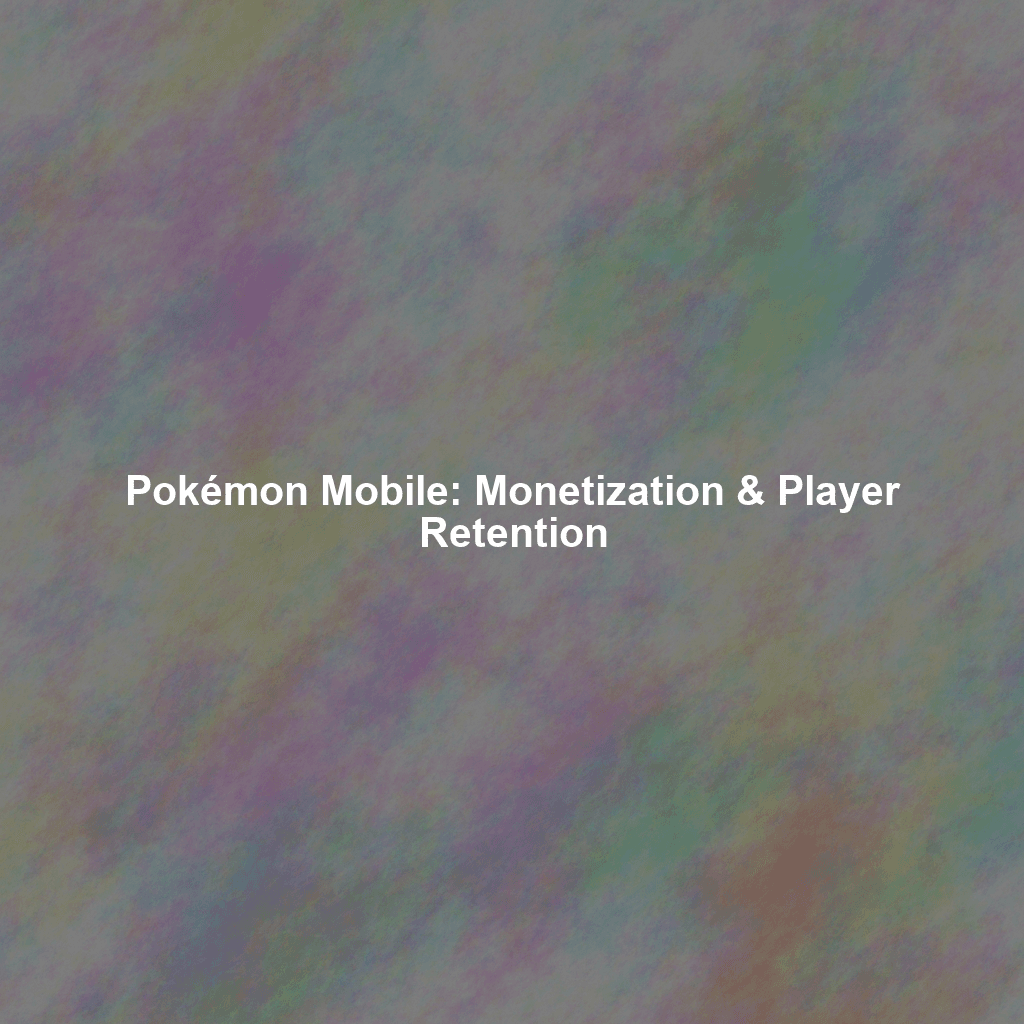Disclaimer: The information provided in this article is based on publicly available data, industry analysis, and our team’s extensive research in the mobile gaming and marketing sectors. While we strive for accuracy, the mobile gaming landscape is constantly evolving.
Monetization Strategies: Catching Profits Alongside Pokémon
Pokémon’s mobile games employ a variety of monetization strategies, primarily centered around in-app purchases (IAPs) and gacha mechanics. These strategies are designed to provide value to players while also generating revenue for the developers.
In-App Purchases (IAPs): A Variety of Options for Trainers
IAPs in Pokémon mobile games typically fall into several categories:
- Premium Currency: Games like Pokémon GO and Pokémon Masters EX offer premium currency (e.g., PokéCoins, Gems) that can be purchased with real money. This currency can then be used to buy items, upgrades, or participate in gacha pulls.
- Items and Consumables: Players can purchase items that enhance gameplay, such as Poké Balls, Potions, Revives (in Pokémon GO), or training manuals and level-up materials (in Pokémon Masters EX).
- Inventory Upgrades: As players progress, their inventory space can become limited. IAPs allow them to expand their inventory, enabling them to collect more Pokémon and items.
- Cosmetic Items: Customization is a significant aspect of many Pokémon games. IAPs often offer cosmetic items, such as trainer outfits and accessories, allowing players to personalize their experience.
The key to successful IAP implementation is balance. The purchases must feel valuable and enhance the player’s experience without creating a “pay-to-win” environment that alienates free-to-play users. Pokémon games generally strike this balance well, offering IAPs that provide convenience and customization rather than outright advantages.
Gacha Mechanics: The Thrill of the Draw
Gacha mechanics, inspired by Japanese capsule-toy vending machines, are a common monetization strategy in mobile games. Players spend in-game currency (often purchasable with real money) to “pull” for a random reward, such as a powerful Pokémon, a rare item, or a sought-after character.
Examples in Pokémon games:
- Pokémon Masters EX: Relies heavily on gacha for obtaining Sync Pairs (combinations of trainers and Pokémon). Different Sync Pairs have varying rarities, with players often spending significant resources to obtain the most powerful ones.
- Pokémon Café ReMix: While less central, gacha mechanics are present for obtaining helper Pokémon with special skills.
Gacha systems can be highly lucrative, but they also raise ethical concerns. “Whales” (players who spend large sums of money) can contribute significantly to revenue, but excessive reliance on gacha can lead to player burnout and negative publicity. Responsible implementation includes:
- Clear Odds Disclosure: Transparency about the probability of obtaining specific rewards is crucial for building trust. Reputable games disclose the odds of each pull.
- Pity Systems: These systems guarantee a valuable reward after a certain number of unsuccessful pulls, mitigating the frustration of repeated failures. Pokémon Masters EX, for example, features a “Scout Points” system that allows players to eventually guarantee a desired Sync Pair.
- Avoiding Predatory Practices: Developers should avoid manipulating players into spending excessively, such as creating artificial scarcity or employing deceptive marketing tactics.
Gacha mechanics are a powerful tool, but developers must use them responsibly to maintain player trust and avoid regulatory scrutiny. For further reading, consider researching the ongoing discussions around loot boxes and gacha mechanics in gaming. The Entertainment Software Association (ESA) offers resources on this topic (link will be provided in the resources section below).
Player Retention Strategies: Keeping Trainers Coming Back for More
Monetization is only sustainable if players remain engaged with the game. Pokémon’s mobile games employ a range of player retention strategies to keep trainers logging in regularly.
Daily Rewards and Login Bonuses: A Simple Incentive
Daily rewards are a staple of mobile game retention. By simply logging in each day, players receive free items, currency, or other bonuses. This encourages daily engagement and reinforces the habit of playing the game. Pokémon GO, Pokémon Masters EX, and Pokémon Café ReMix all utilize daily rewards systems to incentivize consistent play.
Events and Limited-Time Content: Creating Urgency and Excitement
Regular events are crucial for keeping games fresh and exciting. These events often feature:
- New Pokémon or Characters: Introducing new Pokémon or Sync Pairs (in Pokémon Masters EX) keeps the meta-game evolving and provides players with new goals to pursue.
- Special Challenges and Quests: Events often feature unique challenges and quests that reward players with valuable items and currency.
- Increased Spawn Rates or Drop Rates: Events can temporarily increase the spawn rates of rare Pokémon (in Pokémon GO) or the drop rates of valuable items, creating a sense of urgency and encouraging players to participate.
- Collaboration Events: Partnering with other franchises or brands can attract new players and generate excitement within the existing player base.
The frequency and quality of events are critical. Too few events can lead to boredom, while poorly designed events can frustrate players. Pokémon games generally excel at creating engaging and rewarding events that tie into the broader Pokémon universe.
Social Features and Community Engagement: Fostering a Sense of Belonging
Social features can significantly enhance player retention by fostering a sense of community and encouraging interaction between players.
- Raids (Pokémon GO, Pokémon UNITE): Cooperative raid battles encourage players to team up and work together to defeat powerful Pokémon.
- Friend Systems (Pokémon GO): Allowing players to add friends and exchange gifts provides a social incentive to play the game.
- Guilds/Clubs (Pokémon UNITE): Joining a guild or club provides players with a sense of belonging and encourages them to participate in group activities.
Beyond in-game features, active community management is essential. Developers should engage with players on social media, forums, and other platforms, addressing feedback, answering questions, and fostering a positive and supportive community. The Pokémon Company International has a strong presence on platforms like Twitter and Facebook, regularly engaging with fans and announcing upcoming events and updates. (Links to social media will be provided in the resources section below).
Regular Updates and Content Additions: Keeping the Game Fresh
Consistent updates and content additions are crucial for long-term player retention. These updates can include:
- New Pokémon Generations (Pokémon GO): Gradually introducing new generations of Pokémon keeps the game evolving and provides players with a constant stream of new content to collect.
- New Features and Game Modes: Adding new features and game modes can revitalize the gameplay experience and provide players with new challenges to overcome.
- Balance Changes: Regularly adjusting the balance of the game, such as tweaking the stats of Pokémon or adjusting the effectiveness of items, can prevent the meta-game from becoming stale.
By continuously improving and expanding the game, developers can keep players engaged and coming back for more.
Personalized Experiences and Push Notifications
Modern mobile games are increasingly leveraging data to personalize the player experience. This includes tailoring recommendations, difficulty levels, and even promotional offers based on individual player behavior. Pokémon games, while not always as aggressive as some other mobile titles in this area, utilize push notifications to remind players of daily rewards, ongoing events, and other reasons to return to the game. The effectiveness of push notifications hinges on delivering relevant and timely information without being overly intrusive. Pokémon GO, for instance, might notify players of a rare Pokémon spawning nearby or remind them to complete a research task.
The “Beyond Ash & Pikachu” Synergy: Mobile Games as Part of a Larger Ecosystem
Pokémon’s success in mobile gaming is intrinsically linked to its broader multi-platform strategy. The games are not isolated entities but rather integral components of a vast and interconnected ecosystem. This “Beyond Ash & Pikachu” approach leverages the popularity of the anime, trading cards, and mainline console games to drive awareness and engagement with the mobile titles.
- Cross-Promotion: Events in mobile games often tie into releases in other areas of the Pokémon franchise. For example, the release of a new Pokémon movie might coincide with a special event in Pokémon GO featuring Pokémon from that movie.
- Brand Recognition: The established brand recognition of Pokémon makes it easier to attract new players to the mobile games. Players are already familiar with the characters, settings, and core gameplay mechanics.
- Franchise Loyalty: Mobile games reinforce franchise loyalty by providing players with new ways to engage with the Pokémon universe. They complement the other forms of media, creating a more immersive and comprehensive experience.
This synergistic approach is a key differentiator for Pokémon. Many mobile game developers struggle to build a loyal audience because their games are not part of a larger, more compelling narrative. Pokémon’s mobile games benefit from the decades of history and lore that have been built around the franchise.
Conclusion: Lessons Learned from Pokémon’s Mobile Mastery
Pokémon’s mobile gaming success is a testament to the power of a well-executed monetization strategy, effective player retention techniques, and a cohesive multi-platform marketing approach. By carefully balancing in-app purchases and gacha mechanics, offering engaging events and daily rewards, and fostering a sense of community, Pokémon’s mobile games have created a thriving ecosystem that keeps players coming back for more. And by seamlessly integrating these games into the broader Pokémon universe, they have leveraged the power of the “Beyond Ash & Pikachu” strategy to create a truly immersive and engaging experience for fans worldwide.
For aspiring mobile game developers and marketers, Pokémon’s success provides valuable lessons:
- Prioritize Player Experience: Monetization should enhance, not detract from, the player experience.
- Foster a Sense of Community: Build a strong and supportive community around your game.
- Keep the Game Fresh: Regularly update your game with new content and features.
- Be Transparent and Ethical: Be transparent about monetization mechanics and avoid predatory practices.
- Leverage Brand Recognition (If Applicable): If your game is part of a larger franchise, leverage the existing brand recognition to attract new players.
By following these principles, you can increase your chances of creating a successful and sustainable mobile game.
Resources
- Entertainment Software Association (ESA): https://www.theesa.com/
- Pokémon GO Official Website: https://pokemongolive.com/en/
- Pokémon Masters EX Official Website: https://pokemonmasters-game.com/en-US
- Pokémon UNITE Official Website: https://unite.pokemon.com/en-us/
- Pokémon Official Twitter: https://twitter.com/Pokemon
- Pokémon Official Facebook: https://www.facebook.com/Pokemon/
- Sensor Tower Mobile Game Data: https://sensortower.com/ (Please note: This is a paid service. Access may be required.)
- App Annie (now data.ai) Mobile Game Data: https://www.data.ai/ (Please note: This is a paid service. Access may be required.)
- Game Developer Conference (GDC) Vault: https://gdcvault.com/ (Search for talks on mobile monetization and player retention)
 Skip to content
Skip to content

